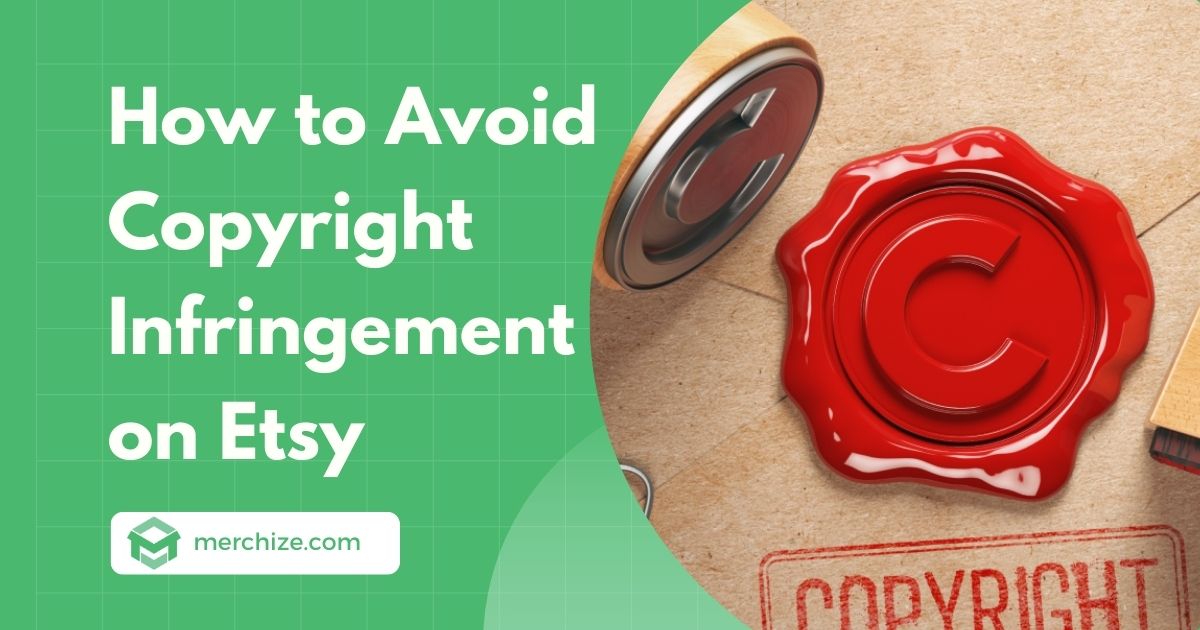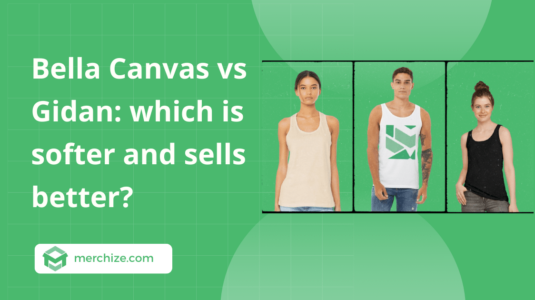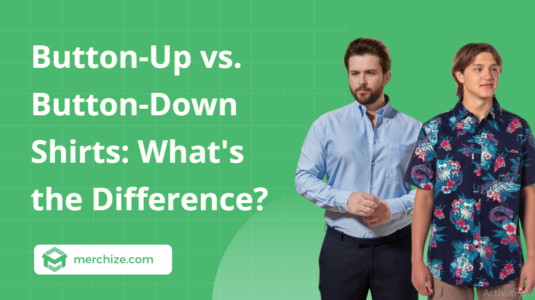Contents
- What is Copyright Infringement?
- What is considered copyright infringement on Etsy?
- What happens if your products are reported for infringement on Etsy?
- How to avoid copyright infringement
- What to avoid putting into your artwork
- What to do if you receive a copyright infringement accusation on Etsy?
- How to report copyright infringement on Etsy?
- Best copyright tips for print-on-demand business
- FAQ:
Copyright infringement has caused the death of many rising stores on Etsy, making it a major concern for many Etsy sellers. If you want to maintain your Etsy business for a long time, it is a must to understand copyright laws and how to avoid copyright infringement on Etsy.
What is Copyright Infringement?
Intellectual property rights
Intellectual property is a special idea or creation invented with one’s mind. Intellectual property can come in the form of an artistic work or an invention. The ownership of such property, just like any other type of property, can be protected by law.
Types of intellectual property
- Trademark: Trademarks could be words, phrases, symbols, names, slogans, or logos that distinguish the goods or services of one company or business from others. Think of the Nike swoosh symbol or the word “Grinch” – these are both trademarked by companies and brands for their products.
Trademarks are also legally recognized if it is registered with government agencies.
- Copyright: This protects original works of authorship, such as books, music, movies, software, or other creative works. It gives the creator the exclusive right to reproduce, distribute, and perform their work. For example, the Harry Potter books by J.K. Rowling are protected by copyright, so nobody else can publish or sell them without her permission.
Unlike trademarks which must be registered in order to be recognized, copyright automatically arises when a creative work is created in a tangible form, like a written book or a recorded song.
- Patent: A patent protects inventions, like new machines, processes, or products. It gives the inventor the exclusive right to make, use, and sell their invention for a certain period, usually 20 years. For instance, the patent for the iPhone protects Apple’s rights to make and sell the device, preventing others from copying it without permission.
- Industrial Design: This protects the visual design of objects that are used in industry or commerce. It covers the appearance or aesthetic aspects of a product. For instance, the unique design of a smartphone or the shape of a car’s headlights can be protected by industrial design rights.
These types of intellectual property rights are essential for encouraging innovation, creativity, and fair competition in various industries. They ensure that creators and inventors are rewarded for their efforts and that consumers can trust the quality and authenticity of the products and services they purchase.
Copyright infringement
Copyright infringement is the violation of intellectual property rights. In other words, it occurs when someone uses, copies, or distributes creative work without the permission of the person who owns the rights to that work.
For instance, if someone downloads a song from the internet and shares it with others without paying for it or getting permission, that’s also copyright infringement.
What is considered copyright infringement on Etsy?
Etsy or any other online e-commerce platform has strict rules when it comes to copyright infringement. When you open a store on Etsy, you have already agreed with their Intellectual Property Policy. These policies are introduced to preserve Etsy as a safe and fair marketplace for all sellers.
According to their policy, sellers would face corresponding punishment if they violated the copyright property rights. In order to protect your store and business on Etsy, you must understand and obey Etsy rules regarding intellectual property.
Here are a few ways that might make you violate the intellectual property right on Etsy:
- Use copyrighted images on your product: This is the most type of common infringement on Etsy. If your product features copyrighted images, be it a character from a movie, TV show, or video game, without gaining a license or permission from the copyright owner, you are infringing intellectual property.
- Use copyrighted designs on your products: Other than images or creatives created by others, Etsy sellers might run the risk of infringing if they sell products that use copyrighted designs like patterns or prints. Be careful when using design elements and patterns from online resources.
- Use trademarked words or terms in your product descriptions: Don’t use any words that are obviously related to brands. There are also many words that are so popular that sometimes people forget that they are trademarked, therefore, accidentally committing intellectual property.
- Copy product descriptions or titles: Copying descriptions or titles from others without obtaining permission is also classified as a form of copyright infringement.
- Sell reproduced copyrighted works: If your product is a copy version of other people’s work, without obtaining permission from the actual owner of the original work, it is also considered a case of copyright infringement.
However, it should be noted that Etsy doesn’t automatically report or act on copyrighted infringement on themselves. Copyright infringement must be reported by the copyright owner only via their copyright reporting system.
What happens if your products are reported for infringement on Etsy?
If a copyright owner discovers that their creative material has been used without permission on Etsy, they can file a complaint with Etsy’s Intellectual Property team.
Etsy will then review the complaint and may remove the infringing items from the platform, suspend the seller’s account, or take other actions as necessary to resolve the intellectual property issue.
Additionally, the content creators may choose to pursue legal action against the seller for infringing on their ownership rights.
With Etsy’s reporting system, a copyright owner could file a complaint to Etsy if they found a listing infringing their copyright. When Etsy receives the infringement report from the copyright owner, they will review the report to assess its validity.
If the product is confirmed a violation of intellectual property rights, Etsy may take action like removing the infringing listings and possibly suspending or closing your shop. You might also receive a warning or a notice to resolve the issue with the copyright owner.
You’ll have the opportunity to respond to the infringement report. You can provide any relevant information or evidence to dispute the claim, such as proof of ownership or authorization to use the allegedly infringing content.
If you disagree with Etsy’s decision regarding the infringement claim, you may have the opportunity to appeal the decision. The appeal process typically involves providing additional evidence or arguments to support your case.
From the copyright owner’s side, they can choose to seek further legal action against you for infringing on their ownership rights.
How to avoid copyright infringement
The key is to only sell original creations or properly licensed works. Don’t replicate characters, logos or fabrics without consent. Design your own artworks and crafts reflecting your unique creativity. Seek public domain or affordable royalty-free content to incorporate if needed. Stay vigilant in reviewing listings to spot potential intellectual property violations before posting. Following copyright and trademark laws carefully ensures your Etsy shop stays complaint as you build your brand.
-
Use original artwork/content
The rule of thumb to avoid copyright infringement on Etsy is to create your own original content. Whether it’s hand-drawn illustrations, digital graphic designs, or innovative crafts, infusing your creations with your unique personal flair not only sets you apart but also mitigates any risk of infringement claims.
For example, instead of replicating popular characters from a beloved TV show, put your own spin on them, creating wholly new characters that reflect your style and imagination.
Now, let’s debunk a popular myth about copyright infringement: You can avoid copyright infringement by creating artwork that is inspired by and slightly different from the original works. The truth is if you’re profiting from their likeness, you are also infringing the copyright.
In addition, you can’t avoid the accusation of trademark and copyright infringement by using vague descriptions on your listing.
For example, you can’t avoid copyright infringement by using terms like “animated mouse with round ears”.
-
Get permission to use copyrighted artwork
It’s not entirely impossible to use copyrighted works on your products. However, you must ensure that you get permission from the original creator or copyright holder to use the material for commercial purposes. This could involve obtaining a license or written consent, ensuring you have the legal right to utilize the artwork in your creations.
Here’s a catch that many sellers falsely assume when it comes to gaining permission to use copyrighted artworks: Paying to use licensed artworks doesn’t mean you gain the right to use these works for commercial purposes.
Some creators allow people who purchase their works to use them in commercial products. However, it’s not always the case. You should check the license carefully for guidelines for proper usage. You can also contact the copyright owners to inquire about licensing their artwork for your products.
-
Use public domain content
Don’t lose hope yet if you don’t have the knack for design. There is still a chance for you to legally integrate other’s creative works into your products without offending the copyright infringement. The secret is to use public-domain content.
Public domain content refers to creative works that are not protected by copyright law or whose copyright has expired or been waived. In simpler terms, it’s material that anyone can use freely without needing permission from the original creator or copyright holder.
You can explore platforms like Wikimedia Commons or Project Gutenberg for a vast collection of public domain images, texts, and other resources to incorporate into your crafts.
-
Use royalty-free content
Royalty-free content, while not free like public domain materials, offers affordable licensing options for creators. By purchasing royalty-free images, fonts, or music, you gain the right to use them in your products without worrying about copyright violations.
Websites like Shutterstock or Adobe Stock provide high-quality royalty-free assets suitable for various creative projects, giving you peace of mind as you build your Etsy store.
-
Check your content carefully for any potential copyright issue
Vigilance is key when it comes to avoiding copyright infringement. Before listing your products on Etsy, thoroughly review your content to identify any potential copyright concerns. This includes scrutinizing elements such as images, text, and even product descriptions for any unauthorized use of copyrighted or trademarked material.
Utilize online tools like Google Images’ reverse image search or copyright verification services to verify the origins of your content and ensure it’s free from infringement.
What to avoid putting into your artwork
Steer clear of incorporating trademarked logos, copyrighted characters, fabrics, or even trademarked words into your creations. These elements are protected by intellectual property laws and using them without proper authorization can lead to legal repercussions.
- Trademarked logos
- Copyrighted characters
- Copyrighted fabric
- Trademarked words
What to do if you receive a copyright infringement accusation on Etsy?
If you find yourself on the receiving end of a copyright infringement accusation, it’s essential to handle the situation promptly and professionally.
You can follow the following process to minimize the impact of the copyright infringement accusations. However, the process of revolving copyright infringement could be time-consuming and expensive, not to mention that you also risk losing your Etsy store entirely. So, it’s best that you avoid getting into this situation in the first place, at all costs.
- Review: Carefully assess the validity of the claim and review your content to determine if there’s any basis for the accusation.
- Respond: Respond to the accusation courteously and transparently, providing any relevant information or evidence to support your case.
- Remove: If the infringement claim is valid, promptly remove the infringing content from your Etsy store to mitigate further legal action.
- Seek legal advice: If the situation escalates or you’re unsure how to proceed, seek legal advice from a qualified attorney specializing in intellectual property law.
How to report copyright infringement on Etsy?
Besides avoiding copyright infringement, sellers on Etsy should also know how to protect their copyrights from being infringed by others.
Fortunately, Etsy has made it easy for sellers to report copyright infringement issues via their dedicated reporting system. After registering with Etsy Reporting Portal, you can file your report.
Your information
You must provide some information about yourself, your address, and contact information. Then you.
Intellectual property
Next, you can include information regarding your intellectual property. Depending on the type of intellectual property, Etsy will ask you to include more details about the property.
Copyright Infringement
- Name or title of the copyrighted work
- Type of copyrighted work
- Examples of the copyrighted work (You can provide your online links to the work. If the work isn’t online, you can describe it in detail)
- Confirm if your copyright is registered
- If you have registered the copyright, proceed to provide details about where the copyright is registered and registration Number
Trademark Infringement or counterfeit
- Trademark
- Confirm if your trademark is registered
- If yes, you can proceed to provide details about the registration number, the jurisdiction of the trademark, and classes of trademark
Infringing materials
At this step, you will have to include the information of the Etsy shop and Etsy listing that is infringing on your intellectual property.
Authorization
The last step is to authorize Etsy to make the complaint on behalf of the intellectual property owner.
After your report is submitted, Etsy will review your cases and do the necessary. After 3 working days, if you still haven’t yet received further information or confirmation, you can try filling out the IP infringement report again.
Best copyright tips for print-on-demand business
A successful print-on-demand business all boils down to how great the designs are. That’s why protecting the copyright of your print-on-demand designs is very crucial.
On the other hand, it’s just as important to stay clear away from any copyright dispute. E-commerce platforms like Etsy are very strict when it comes to copyright protection. In the worst case, your store will be permanently closed.
Even when you’re selling on your own website, it is still risky to be careless about copyright issues as you might get into legal issues with copyright owners.
Most importantly, respecting copyright is the right thing to do. It not only protects your business from legal issues but also builds trust with your customers, and establishes your brand as an ethical and reliable one.
Keep an eye on the latest copyright news
Each day, there are plenty of newly registered trademarks and copyrights as well as many others that expire. That’s why you should continuously update new trademarked words, terms, and logos. By doing this, you can avoid potential risks and identify new opportunities.
Besides, one of the best ways to know more about copyright and avoid copyright infringement is to learn from real experience and case studies. There are many communities online where sellers share and discuss their experiences regarding copyright infringement. By joining these spaces, you can learn more about copyright infringement from real examples. You can also seek help from experienced sellers from these communities if you encounter any trouble with copyright infringement.
Be Careful With AI Art
AI art has been a new big thing in the print on demand industry. New AI generative tools have helped many people turn their ideas from simple text and prompts into artwork.
While many people considered AI arts a new revolution that would lead to many exciting possibilities, many concerns about the legitimacy of AI art, especially regarding the copyright. It’s essential to ensure that the resulting artwork does not violate copyright laws or infringe upon existing intellectual property.
Don’t blindly follow what people are selling
When it comes to copyright infringement, you should remember that you just can’t follow what other people are doing. Even when someone is doing great selling copyrighted or trademarked products, it doesn’t mean what they are doing is legally accepted. These sellers might not be aware of the potential risks or they choose profits over intellectual property rights.
Blindly mimicking popular designs without considering their copyright status is a recipe for disaster. Instead, focus on creating original and unique content that sets your brand apart.
If you notice that a particular type of design, such as minimalist typography, is gaining traction among sellers, take inspiration from the trend rather than directly copying existing designs. Infuse your own creativity and style into your creations to ensure they stand out while avoiding copyright infringement.
FAQ:
Is there any maximum number of copyright strikes on Etsy?
There is no specific rule about the number of strikes a shop can get before they face consequences such as account suspension or termination. Etsy will take into consideration the severity of the case and decide the punishment accordingly. Even if it’s the first time you get reported for violating intellectual property rights, Etsy can still take down your store. It’s crucial for sellers to adhere to copyright laws and Etsy’s guidelines to maintain a positive reputation and avoid potential penalties.
Can I sell Disney artwork on Etsy?
Disney is very strict and protective of its copyrights and trademarks. They generally do not permit the unauthorized use of their intellectual property for commercial purposes, including selling products featuring Disney characters or designs.
Selling Disney artwork like Disney characters, logos, and other intellectual property on Etsy can be problematic due to copyright and trademark laws. Using these materials without proper authorization from Disney can lead to legal consequences, including account suspension or termination on Etsy.
If you wish to sell Disney-inspired artwork on Etsy, you must obtain proper licensing or authorization from Disney or its authorized representatives.
Can I use copyrighted material if I give the original creator credit?
No. Giving credit to the original creator does not automatically grant you the right to use copyrighted material without permission.
It’s the creators’ and copyright owners’ right to control how their work is used, reproduced, and distributed. While providing credit to the original creator is a respectful gesture, using copyrighted material without permission can still be considered copyright infringement.
Can I sell fan art on Etsy?
The simple answer is no if you don’t obtain permission or a license to sell your own fan art. Of course, there are a few creators or copyright owners who allow others to render





